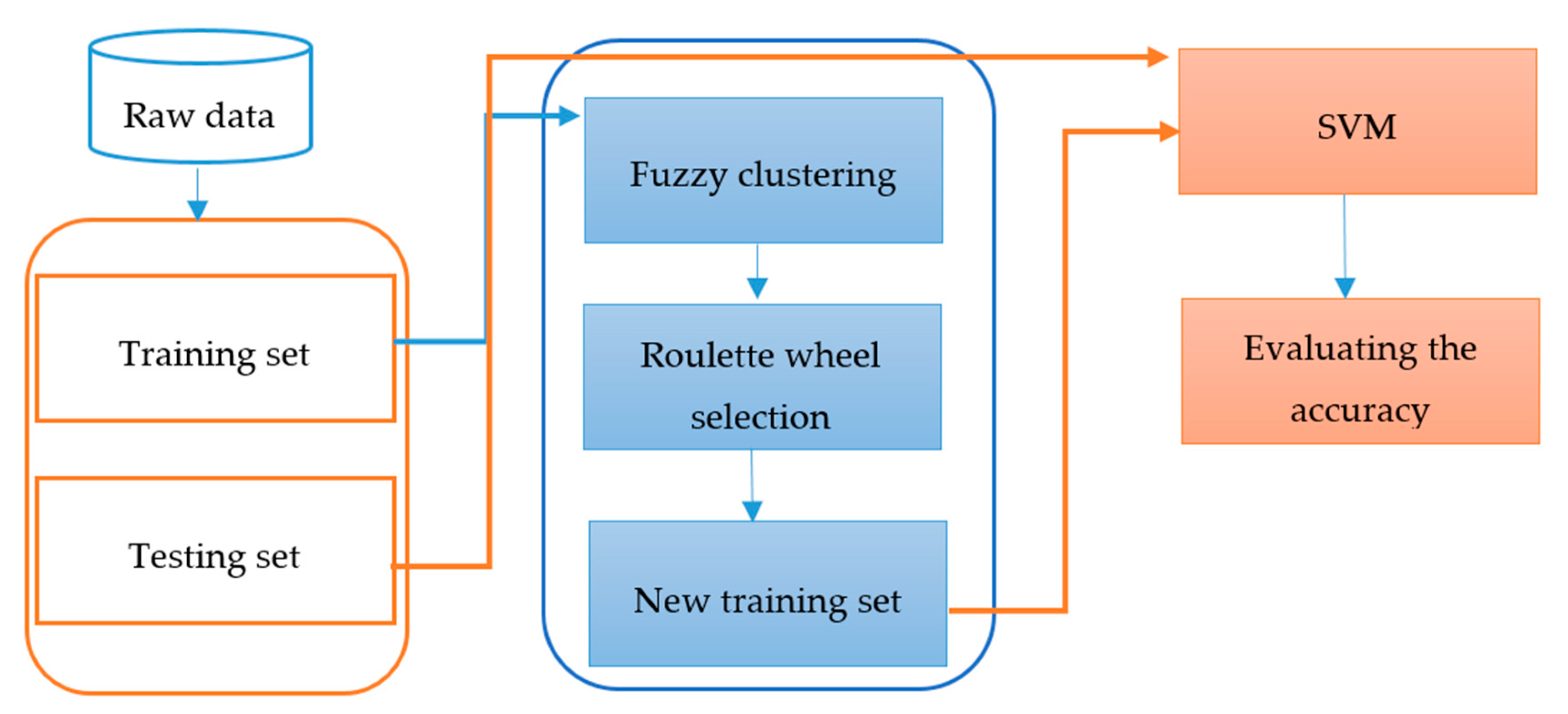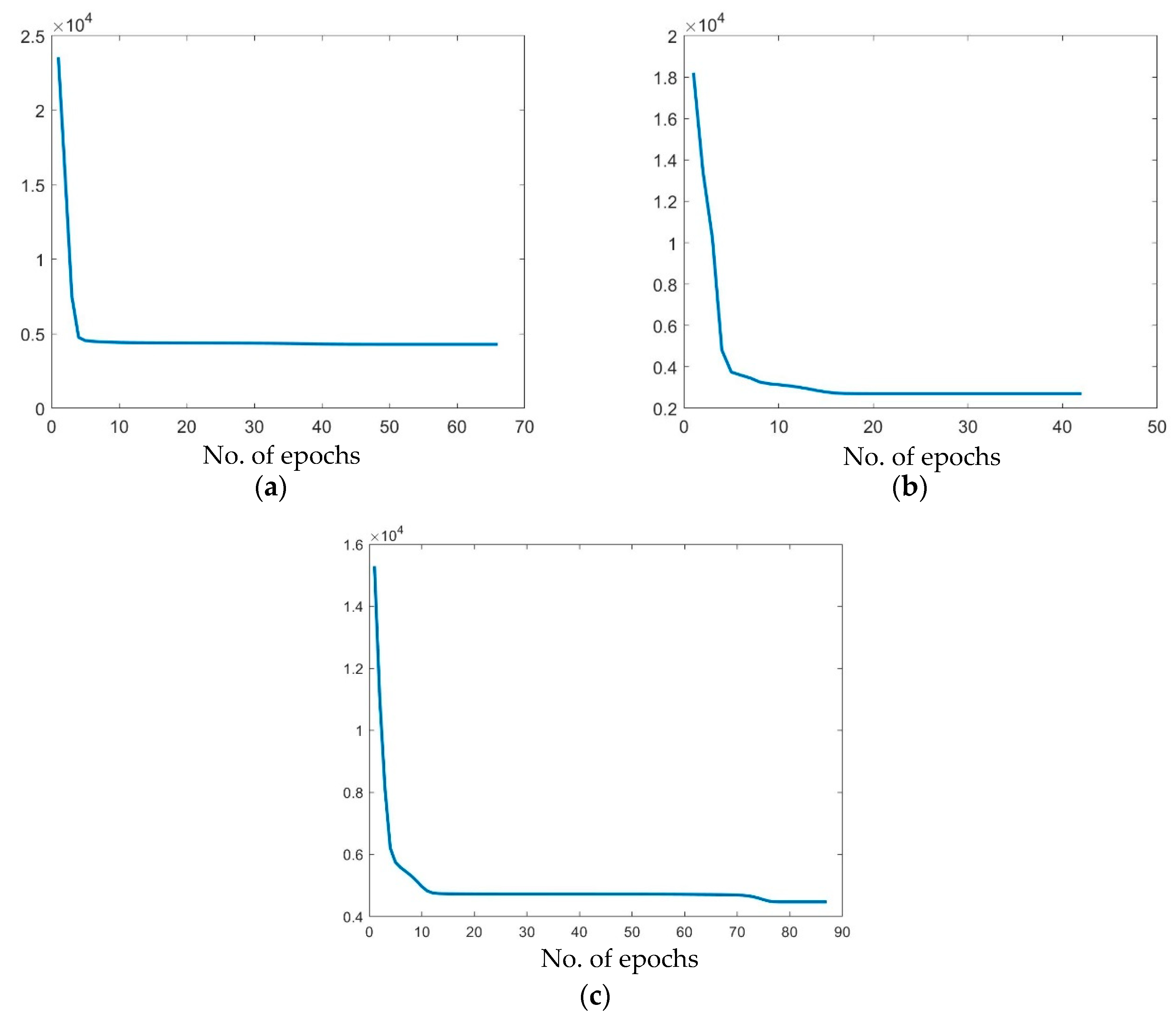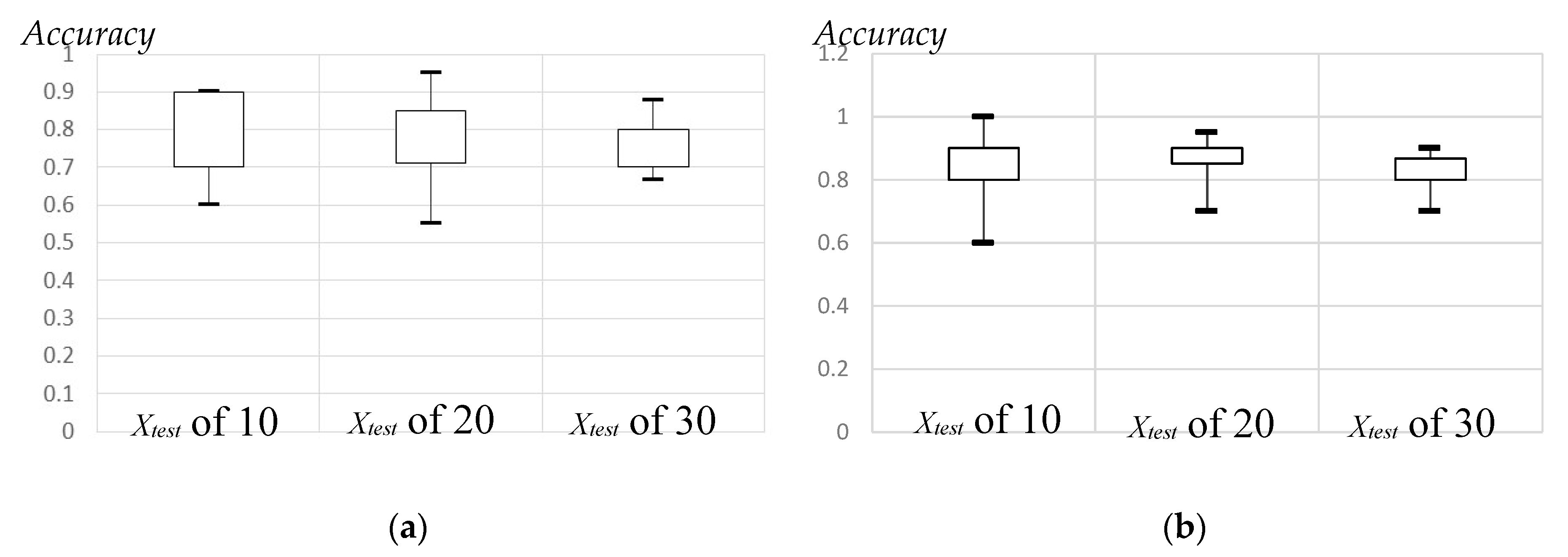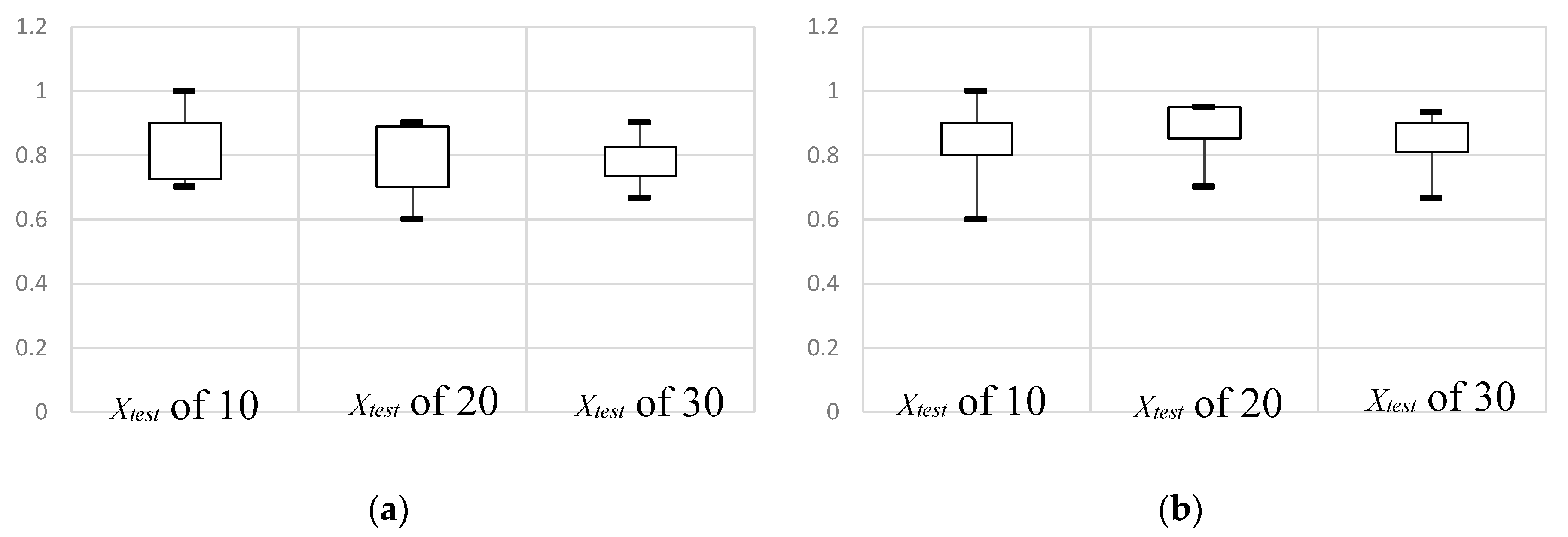Developing Support Vector Machine with New Fuzzy Selection for the Infringement of a Patent Rights Problem
Abstract
1. Introduction
2. Support Vector Machine with New Fuzzy Selection
2.1. New Fuzzy Selection
| Algorithm 1: Fuzzy Roulette Wheel Selection with Membership Function |
| For I < Max size |
| Generate Max size random number γ |
| Calculate cumulative membership U, total fitness μI and sum of proportional membership Σui |
| Spin the wheel Max size times |
| If Σui < γ then |
| Select the dataset as training set (Xtrain) and testing (Xtest) datasets, otherwise, index to outlier dataset |
| End if |
| End |
| Return dataset with membership value proportional to the size of selexted wheel section |
| End Procedure |
2.2. SVMFS
3. Patent Infringement Problem
3.1. Data
3.2. Statistical Comparison with Different Numbers of Testing Datasets
3.3. The Results Analysis
4. Conclusions
Author Contributions
Funding
Conflicts of Interest
References
- García-Gil, D.; Luengo, J.; García, S.; Herrera, F. Enabling Smart Data: Noise filtering in Big Data classification. Inf. Sci. 2019, 479, 135–152. [Google Scholar] [CrossRef]
- van der Gaag, K.J.; Hoogenboom, J.; Busscher, L.; Benschop, C.C.G.; Zuñiga, S.; Sijen, T. The impact of FDSTools noise correction on the analysis of data from the Forenseq™ DNA Signature Prep Kit. Forensic Sci. Int. Genet. Suppl. Ser. 2019, 7, 797–799. [Google Scholar] [CrossRef]
- Niu, X.; Wang, J. A combined model based on data preprocessing strategy and multi-objective optimization algorithm for short-term wind speed forecasting. Appl. Energy 2019, 241, 519–539. [Google Scholar] [CrossRef]
- Cai, L.; Zhang, Z.; Yang, J.; Yu, Y.; Zhou, T. A noise-immune Kalman filter for short-term traffic flow forecasting. Physica 2019, 536, 122601. [Google Scholar] [CrossRef]
- Liu, H.; Chen, C. Data processing strategies in wind energy forecasting models and applications: A comprehensive review. Appl. Energy 2019, 249, 392–408. [Google Scholar] [CrossRef]
- Ma, W.; Qiu, J.; Liu, X.; Xiao, G.; Duan, J.; Chen, B. Unscented Kalman Filter With Generalized Correntropy Loss for Robust Power System Forecasting-Aided State Estimation. IEEE Trans. Ind. Inform. 2019, 15, 6091–6100. [Google Scholar] [CrossRef]
- Wang, D.; Borthwick, A.G.; He, H.; Wang, Y.; Zhu, J.; Lu, Y.; Xu, P.; Zeng, X.; Wu, J.; Wang, L.; et al. A hybrid wavelet de-noising and Rank-Set Pair Analysis approach for forecasting hydro-meteorological time series. Environ. Res. 2018, 160, 269–281. [Google Scholar] [CrossRef]
- Florez-Lozano, J.; Caraffini, F.; Parra, C.; Gongora, M. Cooperative and distributed decision-making in a multi-agent perception system for improvised land mines detection. Inf. Fusion 2020, 64, 32–49. [Google Scholar] [CrossRef]
- Tang, D.; Qin, B.; Wei, F.; Dong, L.; Liu, T.; Zhou, M. A Joint Segmentation and Classification Framework for Sentence Level Sentiment Classification. IEEE/ACM Trans. Audio Speech Lang. Process. 2015, 23, 1750–1761. [Google Scholar] [CrossRef]
- Jiang, J.-J.; Duan, F.-J.; Wang, X.-Q. An Efficient Classification Method of Mixed Sources. IEEE Sens. J. 2016, 16, 3731–3734. [Google Scholar]
- Kasabov, N.K.; Doborjeh, M.G.; Doborjeh, Z.G. Mapping, Learning, Visualization, Classification, and Understanding of fMRI Data in the NeuCube Evolving Spatiotemporal Data Machine of Spiking Neural Networks. IEEE Trans. Neural Netw. Learn. Syst. 2017, 28, 887–899. [Google Scholar] [CrossRef]
- Shao, J.; Huang, F.; Yang, Q.; Luo, G. Robust Prototype-Based Learning on Data Streams. IEEE Trans. Knowl. Data Eng. 2018, 30, 978–991. [Google Scholar] [CrossRef]
- Wang, B.; Zhang, J.; Zhang, Z.; Pan, L.; Xiang, Y.; Xia, D. Noise-Resistant Statistical Traffic Classification. IEEE Trans. Big Data 2019, 5, 454–466. [Google Scholar] [CrossRef]
- Phan, H.; Andreotti, F.; Cooray, N.; Chén, O.Y.; de Vos, M. Joint Classification and Prediction CNN Framework for Automatic Sleep Stage Classification. IEEE Trans. Biomed. Eng. 2019, 66, 1285–1296. [Google Scholar] [CrossRef]
- Basha, N.; Sheriffa, M.Z.; Kravaris, C.; Nounou, H.; Nounou, M. Multiclass data classification using fault detection-based techniques. Comput. Chem. Eng. 2020, 136, 106786. [Google Scholar] [CrossRef]
- Asuncion, A.; Newman, D. UCI Machine Learning Repository. 2007. Available online: https://archive.ics.uci.edu/ml/index.php (accessed on 16 May 2020).
- Ekong, U.; Lam, H.K.; Xiao, B.; Ouyang, G.; Liu, H.; Chan, K.; Ling, S.H. Classification of epilepsy seizure phase using interval type-2 fuzzy support vector machines. Neurocomputing 2016, 199, 66–76. [Google Scholar] [CrossRef]
- Shen, L.; Chen, H.; Yu, Z.; Kang, W.; Zhang, B.; Li, H.; Yang, B.; Liu, D. Evolving support vector machines using fruit fly optimization for medical data classification. Knowl. Based Syst. 2016, 96, 61–75. [Google Scholar] [CrossRef]
- Wang, D.; Zhang, X.; Fan, M.; Ye, X. Hierarchical mixing linear support vector machines for nonlinear classification. Pattern Recognit. 2016, 59, 255–267. [Google Scholar] [CrossRef]
- Zhong, J.; Tse, P.W.; Wang, D. Novel Bayesian inference on optimal parameters of support vector machines and its application to industrial survey data classification. Neurocomputing 2016, 211, 159–171. [Google Scholar] [CrossRef]
- Qi, Z.; Wang, B.; Tian, Y.; Zhang, P. When Ensemble Learning Meets Deep Learning: A New Deep Support Vector Machine for Classification. Knowl. Based Syst. 2016, 107, 54–60. [Google Scholar] [CrossRef]
- Liu, Y.; Bi, J.-W.; Fan, Z.-P. A method for multi-class sentiment classification based on an improved one-vs-one (OVO) strategy and the support vector machine (SVM) algorithm. Inf. Sci. 2017, 394, 38–52. [Google Scholar] [CrossRef]
- Zhang, X.; Ding, S.; Xue, Y. An improved multiple birth support vector machine for pattern classification. Neurocomputing 2017, 225, 119–128. [Google Scholar] [CrossRef]
- Utkin, L.V.; Zhuk, Y.A. An one-class classification support vector machine model by interval-valued training data. Knowl. Based Syst. 2017, 120, 43–56. [Google Scholar] [CrossRef]
- Gonzalez-Abril, L.; Angulo, C.; Nuñez, H.; Leal, Y. Handling binary classification problems with a priority class by using Support Vector Machines. Appl. Soft Comput. 2017, 61, 661–669. [Google Scholar] [CrossRef][Green Version]
- Kusakci, A.O.; Ayvaz, B.; Karakaya, E. Towards an autonomous human chromosome classification system using Competitive Support Vector Machines Teams (CSVMT). Expert Syst. Appl. 2017, 86, 224–234. [Google Scholar] [CrossRef]
- Richhariy, B.; Tanveer, M. EEG signal classification using universum support vector machine. Expert Syst. Appl. 2018, 106, 169–182. [Google Scholar] [CrossRef]
- Ougiaroglou, S.; Diamantaras, K.I.; Evangelidis, G. Exploring the effect of data reduction on Neural Network and Support Vector Machine classification. Neurocomputing 2018, 280, 101–110. [Google Scholar] [CrossRef]
- de Lima, M.D.; Costa, N.L.; Barbosa, R. Improvements on least squares twin multi-class classification support vector machine. Neurocomputing 2018, 313, 196–205. [Google Scholar] [CrossRef]
- Tang, L.; Tian, Y.; Pardalos, P.M. A novel perspective on multiclass classification: Regular simplex support vector machine. Inf. Sci. 2019, 480, 324–338. [Google Scholar] [CrossRef]
- Yang, L.; Dong, H. Robust support vector machine with generalized quantile loss for classification and regression. Appl. Soft Comput. 2019, 81, 105483. [Google Scholar] [CrossRef]
- Okwuashi, O.; Ndehedehe, C.E. Deep support vector machine for hyperspectral image classification. Pattern Recognit. 2020, 103, 107298. [Google Scholar] [CrossRef]
- Juang, C.-F.; Hsieh, C.-D. Fuzzy c-means bases support vector machine for channel equalisation. Int. J. Gen. Syst. 2009, 38, 273–289. [Google Scholar] [CrossRef]
- Yang, X.; Zhang, G.; Lu, J. A kernel fuzzy c-means clustering-based fuzzy support vector machine algorithm for classification problems with outliers or noises. IEEE Trans. Fuzzy Syst. 2011, 19, 105–115. [Google Scholar] [CrossRef]
- Demidova, L.; Sokolova, Y.; Nikulchev, E. Use of fuzzy clustering algorithms ensemble for SVM classifier development. Int. Rev. Model. Simul. 2015, 8, 446–457. [Google Scholar]
- Eşme, E.; Karlik, B. Fuzzy c-means based support vector machines classifier for perfume recognition. Appl. Soft Comput. 2016, 46, 452–458. [Google Scholar] [CrossRef]
- Karlik, B. The positive effects of fuzzy c-means clustering on supervised learning classifiers. Int. J. Artif. Intell. Expert Syst. 2016, 7, 1–8. [Google Scholar]
- Subudhi, S.; Panigrahi, S. Use of fuzzy clustering and support vector machine for detecting fraud in mobile telecommunication networks. Int. J. Secur. Netw. 2016, 11, 3–11. [Google Scholar] [CrossRef]
- Bezdek, J.C. Pattern Recognition with Fuzzy Objective Function Algorithms; Plenum Press: New York, NY, USA, 1981. [Google Scholar]
- Dunn, J.C. A fuzzy relative of the ISODATA process and its use in detecting compact well-seperated clusters. J. Cybern. 1973, 3, 32–57. [Google Scholar] [CrossRef]
- Jain, A.K.; Dubes, R.C. Algorithm for Clustering Data; Prentice-Hall: New Jersey, NJ, USA, 1988. [Google Scholar]
- Vapnik, V. The Nature of Statistical Learning Theory; Springer: Berlin/Heidelberg, Germany, 1995. [Google Scholar]
- Vapnik, V.; Golowich, S.; Smola, A. Support vector machine for function approximation, regression estimation, and signal processing. Adv. Neural Inf. Process. Syst. 1996, 9, 281–287. [Google Scholar]
- Duleba, S.; Farkas, B. Principal Component Analysis of the Potential for Increased Rail Competitivenessin East-Central Europe. Sustainability 2019, 11, 4181. [Google Scholar] [CrossRef]
- Aitizem, T.; Bougheloum, W.; Harkat, M.F.; Djeghaba, M. Fault Detection and Isolation Using Interval Principal Component Analysis Methods. IFAC-Pap. 2015, 48, 1402–1407. [Google Scholar]





| Author(s) | Year | Methods | Applied Fields |
|---|---|---|---|
| Ekong et al. [17] | 2016 | Interval type-2 fuzzy SVM | Epileptic seizure phases |
| Shen et al. [18] | 2016 | SVM with fruit fly optimization algorithm | Medical diagnosis |
| Wang et al. [19] | 2016 | Locally linear SVMs | UCI dataset |
| Zhong et al. [20] | 2016 | SVM with novel Bayesian inference | Industrial survey data |
| Qi et al. [21] | 2016 | New Deep SVM | UCI dataset |
| Liu et al. [22] | 2017 | SVM | One-vs-one (OVO) strategy |
| Zhang et al. [23] | 2017 | Multiple birth SVM | UCI dataset |
| Utkin and Zhuk [24] | 2017 | One-class classification SVM | UCI dataset |
| Gonzalez-Abril et al. [25] | 2017 | Modified SVM | UCI dataset |
| Kusakci et al. [26] | 2017 | Competitive SVM Teams | Autonomous human chromosome |
| Richhariy and Tanveer [27] | 2018 | Universum support vector machine | Electroencephalogram |
| Ougiaroglou et al. [28] | 2018 | SVM | KEEL-dataset repository |
| de Lima et al. [29] | 2018 | Least squares twin multi-class SVM | UCI dataset |
| Tang et al. [30] | 2019 | Regular simplex SVM | Benchmark datasets |
| Yang and Dong [31] | 2019 | SVM with generalized quantile loss | UCI dataset |
| Okwuashi and Ndehedehe [32] | 2020 | Deep SVM | Hyperspectral image |
| Variables | Descriptions | Numerical Expression | Maximum | Minimum | Average | Standard Deviation |
|---|---|---|---|---|---|---|
| M | The month of the case | 1 to 12: means January to December | 12 | 1 | 6.602 | 3.140 |
| IPC-M | Uniform classification of patent documents in various countries | 0 to 8 categories | 8 | 0 | 4.839 | 2.705 |
| IPC-S | Uniform classification of patent documents in various countries | 1 to 67 categories | 67 | 1 | 19.989 | 24.078 |
| CC | Three types of patient | 1: Invention patent | 3 | 1 | 1.312 | 0.724 |
| 2: Utility model patent | ||||||
| 3: Design patent | ||||||
| CC-M | Number of rights in patents | 1: Means only one right in patents. | 28 | 1 | 3.108 | 4.390 |
| CC-S | The number of items in a patent that can be independently claimed | 1: Means only one independently claimed. | 4 | 1 | 1.086 | 0.483 |
| SF | The fees charged for each case. | 1 to 14 represent different service charges. | 14 | 1 | 7.742 | 3.077 |
| CL | The identity of the client | 1: Public company | 5 | 1 | 3.269 | 1.275 |
| 2: Medium-sized and small companies | ||||||
| 3: Person | ||||||
| 4: Court | ||||||
| 5: Others | ||||||
| AC | Demonstration of the scale of resources | Amount of authorized capital | 245,000,000,000 | 0 | 6,234,745,161 | 43,447,535,187 |
| A | Law office | 1: Small law office | 4 | 1 | 2.129 | 0.816 |
| 2: Medium-sized law office | ||||||
| 3: Larger law office | ||||||
| 4: Famous law office | ||||||
| EJ | Expected judgment from client | 1: Infringement 0: Non- infringement | 1 | 0 | 0.441 | 0.500 |
| Decision variables | ||||||
| CD | Final judgment from court. | 1: Infringement | 1 | 0 | 0.742 | 0.438 |
| 0: Non-infringement | ||||||
| M | I IPC-M | IPC-S | CC | CC-M | CC-S | SF | CL | AC | A | EC | CD | |
|---|---|---|---|---|---|---|---|---|---|---|---|---|
| Case 1 | 1 | 7 | 1 | 3 | 5 | 1 | 11 | 3 | 25,000,000 | 2 | 1 | 1 |
| Case 93 | 12 | 5 | 4 | 1 | 2 | 1 | 0 | 5 | 0 | 1 | 3 | 0 |
| M | IPC-M | IPC-S | CC | CC-M | CC-S | SF | CL | AC | A | EC | CD | ||
|---|---|---|---|---|---|---|---|---|---|---|---|---|---|
| M | Pearson Correlation | −0.142 | 0.154 | −0.163 | −0.153 | −0.060 | −0.227 | −0.158 | −0.126 | −0.088 | 0.118 | −0.136 | |
| Sig. (2-tailed) | 0.171 | 0.138 | 0.116 | 0.140 | 0.566 | 0.028 | 0.129 | 0.226 | 0.401 | 0.258 | 0.193 | ||
| IPC-M | Pearson Correlation | −0.533 | 0.200 | 0.394 | 0.325 | 0.280 | 0.148 | 0.227 | −0.065 | 0.197 | −0.028 | ||
| Sig. (2-tailed) | 0.000 | 0.053 | 0.000 | 0.001 | 0.006 | 0.156 | 0.028 | 0.537 | 0.057 | 0.789 | |||
| IPC-S | Pearson Correlation | −0.209 | −0.191 | −0.066 | −0.229 | −0.076 | 0.043 | 0.093 | 0.020 | 0.120 | |||
| Sig. (2-tailed) | 0.043 | 0.066 | 0.525 | 0.026 | 0.466 | 0.683 | 0.370 | 0.851 | 0.251 | ||||
| CC | Pearson Correlation | 0.004 | −0.108 | 0.270 | −0.227 | −0.164 | −0.067 | −0.058 | 0.100 | ||||
| Sig. (2-tailed) | 0.971 | 0.301 | 0.009 | 0.028 | 0.115 | 0.523 | 0.576 | 0.338 | |||||
| CC-M | Pearson Correlation | 0.632 | −0.034 | 0.102 | 0.512 | 0.212 | 0.181 | 0.142 | |||||
| Sig. (2-tailed) | 0.000 | 0.745 | 0.328 | 0.000 | 0.040 | 0.081 | 0.171 | ||||||
| CC-S | Pearson Correlation | −0.006 | 0.091 | 0.483 | 0.267 | 0.260 | −0.019 | ||||||
| Sig. (2-tailed) | 0.954 | 0.382 | 0.000 | 0.009 | 0.011 | 0.858 | |||||||
| SF | Pearson Correlation | −0.138 | −0.077 | 0.006 | −0.054 | 0.016 | |||||||
| Sig. (2-tailed) | 0.185 | 0.460 | 0.957 | 0.603 | 0.878 | ||||||||
| CL | Pearson Correlation | 0.229 | −0.293 | 0.276 | −0.016 | ||||||||
| Sig. (2-tailed) | 0.026 | 0.004 | 0.007 | 0.876 | |||||||||
| AC | Pearson Correlation | 0.067 | 0.201 | 0.106 | |||||||||
| Sig. (2-tailed) | 0.520 | 0.052 | 0.310 | ||||||||||
| A | Pearson Correlation | 0.099 | −0.001 | ||||||||||
| Sig. (2-tailed) | 0.344 | 0.990 | |||||||||||
| EC | Pearson Correlation | −0.107 | |||||||||||
| Sig. (2-tailed) | 0.306 | ||||||||||||
| No. of Xtest | 10 | 20 | 30 | ||||||
|---|---|---|---|---|---|---|---|---|---|
| No. of c | 3 | 4 | 5 | 3 | 4 | 5 | 3 | 4 | 5 |
| LSSVMFS | 0.805 (0.105) | 0.785 (0.134) | 0.815 (0.087) | 0.7725 (0.100) | 0.800 (0.06) | 0.7825 (0.092) | 0.7405 (0.06) | 0.7683 (0.047) | 0.78 (0.057) |
| SVMFS | 0.870 (0.103) | 0.865 (0.098) | 0.85 (0.105) | 0.8625 (0.062) | 0.873 (0.079) | 0.875 (0.06) | 0.830 (0.05) | 0.85 (0.045) | 0.846 (0.06) |
| Methods | No. of Testing Set | |||
|---|---|---|---|---|
| 10 | 20 | 30 | ||
| SVM | TPN | 1 | 1 | 1 |
| Accuracy | 0.80 | 0.70 | 0.73 | |
| PCA + SVM | TPN | 1 | 1 | 1 |
| Accuracy | 0.80 | 0.70 | 0.73 | |
| LSSVM | TPN | 1 | 0.93 | 0.91 |
| Accuracy | 0.60 | 0.75 | 0.70 | |
| BPNN | TPN | 0.88 | 0.86 | 0.81 |
| Accuracy | 0.80 | 0.65 | 0.7 | |
| SVMFS | TPN | 1 | 1 | 1 |
| Accuracy | 1 | 0.95 | 0.93 | |
| LSSVMFS | TPN | 1 | 1 | 0.96 |
| Accuracy | 0.9 | 0.9 | 0.87 | |
© 2020 by the authors. Licensee MDPI, Basel, Switzerland. This article is an open access article distributed under the terms and conditions of the Creative Commons Attribution (CC BY) license (http://creativecommons.org/licenses/by/4.0/).
Share and Cite
Chang, C.-Y.; Lin, K.-P. Developing Support Vector Machine with New Fuzzy Selection for the Infringement of a Patent Rights Problem. Mathematics 2020, 8, 1263. https://doi.org/10.3390/math8081263
Chang C-Y, Lin K-P. Developing Support Vector Machine with New Fuzzy Selection for the Infringement of a Patent Rights Problem. Mathematics. 2020; 8(8):1263. https://doi.org/10.3390/math8081263
Chicago/Turabian StyleChang, Chih-Yao, and Kuo-Ping Lin. 2020. "Developing Support Vector Machine with New Fuzzy Selection for the Infringement of a Patent Rights Problem" Mathematics 8, no. 8: 1263. https://doi.org/10.3390/math8081263
APA StyleChang, C.-Y., & Lin, K.-P. (2020). Developing Support Vector Machine with New Fuzzy Selection for the Infringement of a Patent Rights Problem. Mathematics, 8(8), 1263. https://doi.org/10.3390/math8081263





